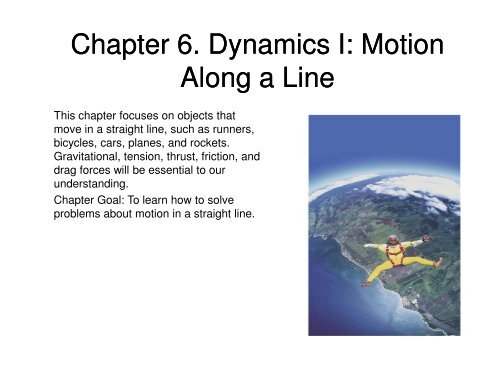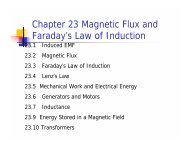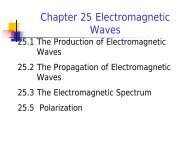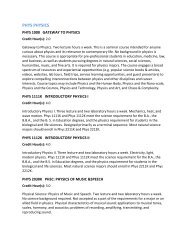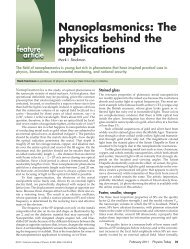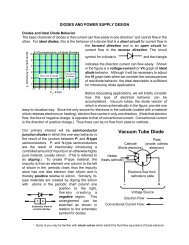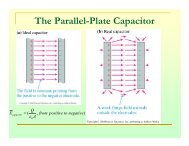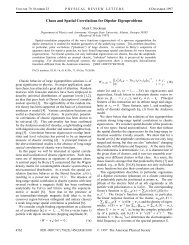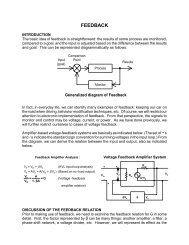Chapter 6. Dynamics I: Motion Along a Line
Chapter 6. Dynamics I: Motion Along a Line
Chapter 6. Dynamics I: Motion Along a Line
You also want an ePaper? Increase the reach of your titles
YUMPU automatically turns print PDFs into web optimized ePapers that Google loves.
<strong>Chapter</strong> <strong>6.</strong> <strong>Dynamics</strong> I: <strong>Motion</strong><br />
<strong>Along</strong> a <strong>Line</strong><br />
This chapter focuses on objects that<br />
move in a straight line, such as runners,<br />
bicycles, cars, planes, and rockets.<br />
Gravitational, tension, thrust, friction, and<br />
drag forces will be essential to our<br />
understanding.<br />
<strong>Chapter</strong> Goal: To learn how to solve<br />
problems about motion in a straight line.
<strong>Chapter</strong> <strong>6.</strong> <strong>Dynamics</strong> I: <strong>Motion</strong><br />
Topics:<br />
• Equilibrium<br />
<strong>Along</strong> a <strong>Line</strong><br />
• Using Newton’s Second Law<br />
• Mass, Weight, and Gravity<br />
• Friction<br />
• Drag<br />
• More Examples of Newton’s<br />
Second Law
1) Object – as a particle<br />
2) Identify all the forces<br />
3) Find the net force (vector sum of all individual forces)<br />
4) Introduce convenient co-ordinate system<br />
5) Find the acceleration of the object (second Newton’s law)<br />
6) With the known acceleration find kinematics of the object<br />
3
The First Class of Problems: Equilibrium<br />
1. Static Equilibrium: no motion (velocity = 0, then acceleration = 0 )<br />
2. Dynamical Equilibrium: no acceleration (velocity = constant)<br />
- In both cases acceleration = 0<br />
- Second Newton’s Law – Net Force = 0<br />
Static Equilibrium:<br />
Convenient co-<br />
ordinate system!!<br />
r r r r<br />
F = T + T + T<br />
=<br />
net<br />
1 2 3<br />
0<br />
− T T cosθ<br />
0<br />
1 + 3 =<br />
− T T sinθ<br />
0<br />
2 + 3 =<br />
4
Special The First Class Class of of Problems: Equilibrium<br />
1. Static Equilibrium: no motion (velocity = 0, then acceleration = 0 )<br />
2. Dynamical Equilibrium: no acceleration (velocity = constant)<br />
Dynamic Equilibrium:<br />
Convenient coordinate<br />
system!!<br />
r<br />
r<br />
r<br />
r<br />
r<br />
F = n + T + w + f<br />
=<br />
net<br />
k<br />
0<br />
k<br />
T − f − w sin θ<br />
=<br />
0<br />
f r n − w cosθ<br />
=<br />
0<br />
k<br />
Kinetic friction<br />
5
The Second Special Class of Problems: Find Equilibrium Acceleration<br />
r<br />
Important:<br />
r F net<br />
- Introduce convenient co-ordinate system!! a =<br />
m<br />
- Understand what the direction of acceleration is!!<br />
a r<br />
f r k<br />
Kinetic friction<br />
r<br />
r r<br />
r r<br />
r<br />
F = n + T + w + f =<br />
ma<br />
net<br />
T − f − w sinθ<br />
=<br />
ma<br />
k<br />
k<br />
n − w cosθ<br />
=<br />
0<br />
6
The Second Special Class of Problems: Find Equilibrium Acceleration<br />
a r<br />
f r k<br />
r<br />
r r<br />
r r<br />
r<br />
F = n + T + w + f =<br />
ma<br />
net<br />
T − f − w sinθ<br />
=<br />
ma<br />
n − w cosθ<br />
=<br />
0<br />
T = 20N<br />
is given<br />
m = 1kg ⇒ w = mg ≈ 10N<br />
is given<br />
k<br />
k<br />
r<br />
a =<br />
r<br />
F net<br />
m<br />
θ =<br />
0<br />
30<br />
is given<br />
Then:<br />
= θ<br />
= =<br />
0<br />
n = w cos = 10cos 30 =<br />
8.7N<br />
T − fk<br />
− w sinθ<br />
20 − fk<br />
−<br />
5<br />
a<br />
= =<br />
m<br />
1<br />
?<br />
7
Friction<br />
Static friction:<br />
f ≤ f = µ n<br />
s<br />
s s,max<br />
s<br />
µ - coefficient of static<br />
friction (it is usually<br />
given in the problem)<br />
n<br />
- normal force<br />
Kinetic friction:<br />
k k<br />
f<br />
= µ n<br />
k<br />
µ - coefficient of kinetic<br />
friction (it is usually<br />
given in the problem)<br />
Rolling friction:<br />
r r<br />
f<br />
= µ n<br />
r<br />
µ - coefficient of rolling<br />
friction (it is usually<br />
given in the problem)<br />
µ > µ ><br />
µ<br />
Usually: s k r<br />
very small<br />
8
Friction<br />
Static friction:<br />
fs ≤ fs,max<br />
= µ<br />
sn<br />
s<br />
n<br />
µ - coefficient of static friction<br />
- normal force<br />
Find the maximum tension,<br />
T max<br />
y<br />
Equilibrium:<br />
r<br />
r<br />
r<br />
r<br />
r<br />
F = n + w + T + f<br />
=<br />
net<br />
n<br />
− w<br />
=<br />
0<br />
s<br />
0<br />
x<br />
n r<br />
T<br />
r<br />
weight,<br />
friction<br />
tension<br />
− f<br />
+ T<br />
=<br />
s<br />
n = w<br />
f = T ≤<br />
f<br />
0<br />
s s,max<br />
f r w r<br />
s<br />
f = µ n =<br />
µ<br />
w<br />
s,max<br />
s s<br />
normal<br />
Condition of equilibrium:<br />
T<br />
≤<br />
µ w<br />
s<br />
T<br />
max<br />
=<br />
µ w<br />
s<br />
9
Friction<br />
Static friction:<br />
Find the maximum tension,<br />
Equilibrium:<br />
r<br />
r<br />
r<br />
r<br />
r<br />
F = n + w + T + f<br />
=<br />
0<br />
net<br />
n<br />
− w<br />
=<br />
0<br />
− f<br />
+ T<br />
=<br />
s<br />
0<br />
s<br />
fs ≤ fs,max<br />
= µ<br />
sn<br />
s<br />
n<br />
T max<br />
f = µ n =<br />
µ<br />
w<br />
s,max<br />
s s<br />
f = T ≤<br />
f<br />
s s,max<br />
µ - coefficient of static friction<br />
- normal force<br />
fs<br />
= T<br />
y<br />
f r s<br />
x<br />
n r<br />
w r<br />
T r<br />
Condition of equilibrium:<br />
T ≤ µ w<br />
T<br />
max<br />
s<br />
= µ w<br />
s<br />
f<br />
s,max<br />
= µ w<br />
s<br />
T max<br />
T<br />
10
Kinetic friction:<br />
k k<br />
f<br />
µ n<br />
Friction<br />
= k<br />
µ - coefficient of kinetic friction<br />
n<br />
- normal force<br />
Find acceleration,<br />
( T > T )<br />
max<br />
y<br />
weight,<br />
r<br />
r r r<br />
r<br />
r<br />
F = n + w + T + f =<br />
ma<br />
net<br />
n<br />
− w<br />
=<br />
0<br />
− f + T =<br />
ma<br />
k<br />
k<br />
f r s<br />
x<br />
n r<br />
w r<br />
a r<br />
T<br />
r<br />
friction<br />
tension<br />
n<br />
= w then fk = µ kn =<br />
µ<br />
kw<br />
normal<br />
a<br />
T −<br />
fk<br />
T −<br />
µ<br />
kw T<br />
= = = −<br />
µ<br />
k<br />
g<br />
m m m<br />
11
Friction<br />
Static friction:<br />
fs ≤ fs,max<br />
= µ<br />
sn<br />
s<br />
n<br />
µ - coefficient of static friction<br />
- normal force<br />
Find the maximum angle, θ max<br />
Equilibrium:<br />
r r<br />
r<br />
r<br />
F = n + w + f<br />
=<br />
net<br />
n − w cos θ<br />
=<br />
0<br />
s<br />
0<br />
− f + w sinθ<br />
=<br />
0<br />
s<br />
n = w cosθ<br />
f = w sinθ<br />
≤<br />
f<br />
s<br />
s,max<br />
f = µ n =<br />
µ w cosθ<br />
s,max<br />
s s<br />
Condition of equilibrium:<br />
w sin<br />
θ ≤<br />
µ w sin cos(theta)<br />
θ<br />
tan<br />
θ ≤<br />
µ<br />
tan<br />
θ =<br />
µ<br />
max<br />
s<br />
s<br />
s<br />
12
Friction<br />
Static friction:<br />
fs ≤ fs,max<br />
= µ<br />
sn<br />
s<br />
n<br />
µ - coefficient of static friction<br />
- normal force<br />
Find the maximum angle, θ max<br />
f = µ n =<br />
µ w cosθ<br />
s,max<br />
s s<br />
f = w sinθ<br />
≤<br />
f<br />
s<br />
s,max<br />
f = w sinθ<br />
s<br />
f<br />
s,max<br />
=<br />
µ w cos<br />
θ<br />
s<br />
θ max<br />
θ<br />
Condition of equilibrium: tan ≤<br />
s<br />
θ µ<br />
13
Kinetic friction:<br />
f<br />
k<br />
µ<br />
Friction<br />
=<br />
kn<br />
k<br />
µ - coefficient of kinetic friction<br />
n<br />
- normal force<br />
Find acceleration<br />
( θ<br />
><br />
θ<br />
)<br />
max<br />
r r r r<br />
r<br />
F = n + w + f =<br />
ma<br />
net<br />
n − w cosθ<br />
=<br />
0<br />
− f + w sinθ<br />
=<br />
ma<br />
k<br />
k<br />
a r<br />
n = w cosθ<br />
then fk = µ kn =<br />
µ kw<br />
cos<br />
θ<br />
− fk<br />
+ w sinθ − µ kw cosθ +<br />
w sinθ<br />
a<br />
= = = g(sinθ −<br />
µ k<br />
cos θ<br />
)<br />
m<br />
m<br />
14
Weight and Apparent Weight<br />
Weight – gravitational force - pulls the objects down<br />
r r m - mass of the object (the same on all planets)<br />
w = mg<br />
How can we measure weight?<br />
g<br />
= 9.8 m - free-fall acceleration (different<br />
2<br />
s on different planets)<br />
1. We can measure mass by comparing with<br />
the known mass<br />
m<br />
unknown<br />
=<br />
m<br />
known<br />
2. We can measure the weight by comparing<br />
with the known force<br />
w = F spring<br />
15
Weight and Apparent Weight<br />
Apparent Weight – reading of the scale<br />
(or the normal force)<br />
In equilibrium:<br />
r<br />
F<br />
net<br />
=<br />
0<br />
then<br />
r r<br />
Fnet<br />
= ma<br />
F − w =<br />
ma<br />
spring<br />
then<br />
F = m( g +<br />
a)<br />
spring<br />
Fspring<br />
=<br />
w<br />
<strong>Motion</strong> with acceleration:<br />
a r<br />
r r<br />
Fnet<br />
= ma<br />
F −<br />
w = −<br />
ma<br />
spring<br />
then<br />
F = m( g −<br />
a)<br />
spring<br />
a r<br />
The man feels heavier than<br />
normal while accelerating upward<br />
The man feels lighter than normal<br />
while accelerating upward<br />
16
<strong>Chapter</strong> <strong>6.</strong> Summary Slides
General Strategy
General Strategy
Important Concepts
Important Concepts
Applications
Applications
An elevator that has descended from the<br />
50th floor is coming to a halt at the 1st<br />
floor. As it does, your apparent weight is<br />
A. less than your true weight.<br />
B. equal to your true weight.<br />
C. more than your true weight.<br />
D. zero.
An elevator that has descended from the<br />
50th floor is coming to a halt at the 1st<br />
floor. As it does, your apparent weight is<br />
A. less than your true weight.<br />
B. equal to your true weight.<br />
C. more than your true weight.<br />
D. zero.
Rank order, from largest to r smallest, r the<br />
size of the friction forces f a to fe in these five<br />
different situations. The box and the floor<br />
are made of the same materials in all<br />
situations.<br />
A. f c > f d > f e > f b > f a .<br />
B. f b > f c = f d = f e > f a .<br />
C. f b > f c > f d > f e > f a .<br />
D. f a > f c = f d = f e > f b .<br />
E. f a = f b > f c = f d = f e .
Rank order, from largest to smallest, the<br />
size of the friction forces r to in these five<br />
different situations. The box and the floor<br />
are made of the same materials in all<br />
situations.<br />
f a<br />
r<br />
fe<br />
A. f c > f d > f e > f b > f a .<br />
B. f b > f c = f d = f e > f a .<br />
C. f b > f c > f d > f e > f a .<br />
D. f a > f c = f d = f e > f b .<br />
E. f a = f b > f c = f d = f e .
The terminal speed of a Styrofoam ball is<br />
15 m/s. Suppose a Styrofoam ball is shot<br />
straight down with an initial speed of<br />
30 m/s. Which velocity graph is correct?
The terminal speed of a Styrofoam ball is<br />
15 m/s. Suppose a Styrofoam ball is<br />
shot straight down with an initial speed of<br />
30 m/s. Which velocity graph is correct?


